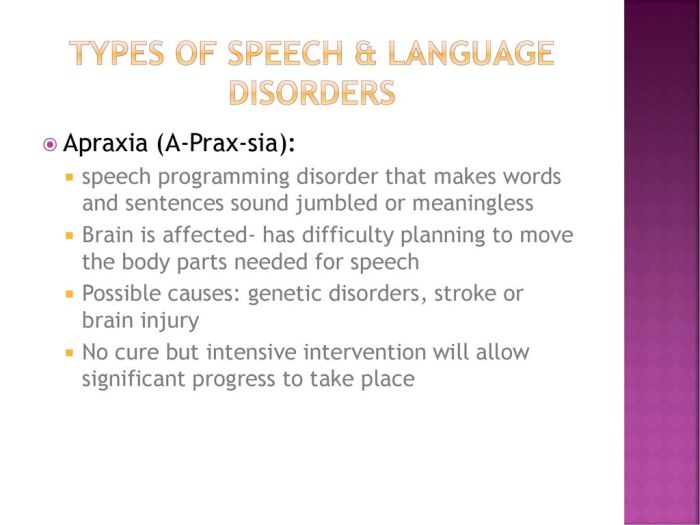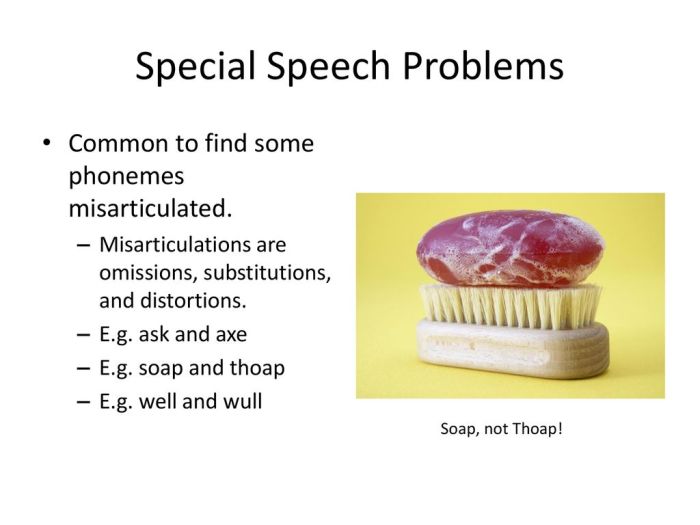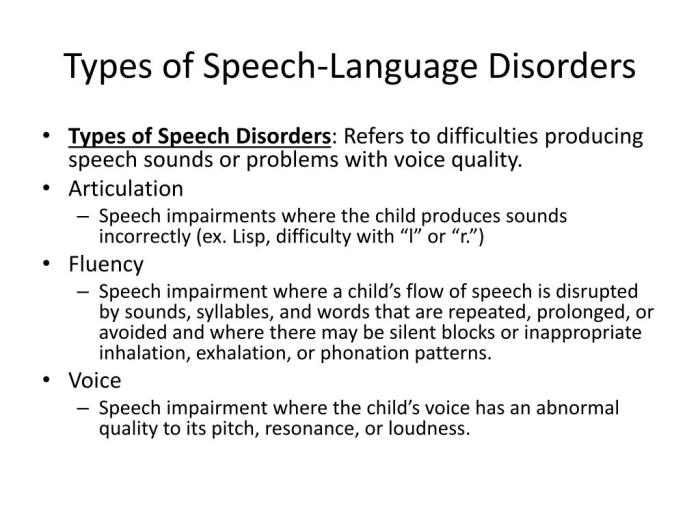Effective communication is fundamental to human interaction, yet many individuals face significant challenges due to speech disorders. Understanding the diverse landscape of these disorders is crucial for timely diagnosis and intervention. This exploration delves into eight common speech disorders, examining their unique characteristics, diagnostic methods, and effective treatment strategies. We will navigate the complexities of differential diagnosis, highlighting the importance of accurate identification for optimal patient outcomes.
From articulation difficulties to fluency problems, the spectrum of speech disorders is broad. This comprehensive overview aims to equip readers with a clearer understanding of these conditions, fostering empathy and promoting informed discussions about effective support and treatment options for those affected.
Overview of Eight Common Speech Disorders

Speech disorders are communication difficulties that affect the way individuals produce, understand, or use language. These disorders can significantly impact various aspects of daily life, including social interactions, academic performance, and professional opportunities. Understanding the different types of speech disorders, their causes, and available treatments is crucial for effective intervention and support.
Definitions and Descriptions of Eight Common Speech Disorders
The following provides concise definitions and descriptions of eight common speech disorders. Prevalence rates are approximate and can vary depending on the population studied and diagnostic criteria used.
| Speech Disorder | Definition/Description | Approximate Prevalence | Key Impact on Daily Life |
|---|---|---|---|
| Articulation Disorder | Difficulty producing speech sounds correctly. This can involve substitutions, omissions, or distortions of sounds. | 10-15% of preschool children | Challenges in clear communication, potential for social isolation, difficulty with reading and writing. |
| Fluency Disorder (Stuttering) | Characterized by interruptions in the flow of speech, including repetitions, prolongations, and blocks. | 5-7% of children, 1% of adults | Anxiety and frustration during communication, avoidance of speaking situations, negative impact on self-esteem. |
| Voice Disorder | Problems with the quality, pitch, loudness, or duration of the voice. This can include hoarseness, breathiness, or vocal nodules. | Prevalence varies greatly depending on the specific disorder and contributing factors. | Difficulty being heard or understood, strain on vocal cords, potential for social withdrawal. |
| Phonological Disorder | Difficulty with the sound system of a language, leading to patterns of sound errors. | Prevalence varies, often co-occurs with articulation disorders. | Challenges in understanding and being understood, difficulty with reading and spelling. |
| Apraxia of Speech | Motor speech disorder characterized by difficulty planning and coordinating the movements needed for speech. | Prevalence is relatively low, exact figures are difficult to obtain due to varied diagnostic criteria. | Significant challenges in producing speech sounds, frustration and difficulty communicating, potential for social isolation. |
| Dysarthria | Weakness or incoordination of the muscles used for speech, often resulting from neurological damage. | Prevalence varies depending on the underlying neurological condition. | Significant difficulties with speech clarity and intelligibility, impacting communication in all aspects of life. |
| Childhood Apraxia of Speech (CAS) | A neurological childhood speech sound disorder in which the precision and consistency of movements underlying speech are impaired. | Prevalence estimates vary widely. | Difficulties with speech sound production, inconsistent errors, limited phonetic inventory. |
| Oral-Motor Disorder | Problems with the muscles of the mouth and throat that affect eating, drinking, and speech. | Prevalence varies widely depending on the underlying cause. | Difficulty with chewing, swallowing, and articulation, impacting nutrition and communication. |
Impact of Speech Disorders on Daily Life
Speech disorders can significantly impact various aspects of an individual’s daily life. For example, children with articulation disorders may experience difficulty in the classroom, struggling to participate in discussions and complete assignments. Adults with fluency disorders might avoid public speaking or job interviews, limiting their professional opportunities. Individuals with voice disorders may experience social isolation due to difficulty being understood or heard. The emotional and psychological impact of a speech disorder can be substantial, leading to feelings of frustration, anxiety, and low self-esteem. The severity of the impact depends on the type and severity of the disorder, as well as the individual’s coping mechanisms and support system. Early intervention and appropriate treatment are crucial to mitigate the negative consequences of these disorders.
Diagnostic Methods and Procedures for Speech Disorders

Accurately diagnosing speech disorders requires a comprehensive assessment conducted by a qualified speech-language pathologist (SLP). The process involves a multifaceted approach utilizing various tools and techniques tailored to the specific suspected disorder. The goal is to identify the nature and severity of the communication impairment, determine its underlying cause, and develop an appropriate intervention plan.
The diagnostic process typically begins with a thorough case history, including information gathered from the individual, family members, and other professionals. This information helps the SLP understand the developmental history, medical history, and educational background of the individual, which can provide valuable clues about the potential cause of the speech disorder. Subsequent assessments involve a variety of formal and informal measures.
Articulation and Phonological Disorder Assessments
Assessment for articulation and phonological disorders typically involves a comprehensive speech sound assessment. This includes a standardized articulation test, which evaluates the production of individual speech sounds in various word positions (initial, medial, and final). The SLP also analyzes the child’s speech sample for patterns of errors, such as sound substitutions, omissions, or distortions. In addition, they may conduct a connected speech sample to observe the child’s speech in a more natural conversational context. Further assessment may include an oral-motor examination to rule out any structural or functional limitations affecting speech production. The assessment results help determine the specific sounds in error, the consistency of errors, and the overall impact on intelligibility.
Fluency Disorder Assessments
Diagnosing fluency disorders, such as stuttering, requires a thorough assessment of speech fluency characteristics. This includes measuring the frequency, type, and duration of disfluencies (e.g., repetitions, prolongations, blocks). The SLP will typically observe the individual’s speech in various speaking contexts, including spontaneous conversation, reading passages, and structured tasks. They may also assess the individual’s perceptions and feelings about their speech, as well as the impact of stuttering on their daily life. Assessment tools include standardized fluency tests and questionnaires. Analyzing the severity, frequency, and context of disfluencies allows the SLP to differentiate between typical disfluencies and clinically significant stuttering.
Language Disorder Assessments
Diagnosing language disorders involves a comprehensive evaluation of various language domains, including receptive and expressive language skills. This typically includes standardized language tests assessing vocabulary, grammar, comprehension, and narrative skills. The SLP also analyzes a language sample to evaluate the individual’s spontaneous language use in a natural conversational context. The sample is analyzed for grammatical accuracy, vocabulary richness, sentence complexity, and overall coherence. Cognitive assessments may be administered to rule out underlying cognitive impairments that may be contributing to the language disorder. Additional assessments may focus on specific aspects of language, such as phonological awareness or pragmatic language skills.
Case Study Examples
The following case studies illustrate the diagnostic process for three different speech disorders:
- Case 1: Articulation Disorder – A 5-year-old child, “Liam,” presented with difficulty producing /s/, /r/, and /l/ sounds. A standardized articulation test revealed consistent errors in these sounds across different word positions. His connected speech sample showed reduced intelligibility due to these sound errors. Oral-motor examination revealed no structural abnormalities. The diagnosis was a phonological articulation disorder.
- Case 2: Fluency Disorder (Stuttering) – An 8-year-old child, “Sarah,” exhibited frequent repetitions and prolongations of sounds and syllables, along with noticeable tension in her speech. A fluency assessment revealed a high frequency of disfluencies across various speaking contexts. She reported feeling anxious about speaking in public and avoiding speaking situations. The diagnosis was childhood-onset stuttering.
- Case 3: Language Disorder (Expressive Language) – A 7-year-old child, “David,” demonstrated difficulties with grammar and sentence structure in his spontaneous speech. A language sample revealed limited sentence complexity and frequent grammatical errors. A standardized language test confirmed deficits in expressive language skills, while receptive language skills were within the normal range. The diagnosis was expressive language disorder.
Differential Diagnosis and Treatment Strategies

Accurately diagnosing speech disorders can be challenging due to the frequent overlap of symptoms across different conditions. Many disorders share similar presentations, making it crucial for clinicians to employ a thorough diagnostic process that considers the entire clinical picture, including the individual’s developmental history, medical history, and a comprehensive speech and language assessment. This section will explore the complexities of differential diagnosis and Artikel effective treatment strategies for each speech disorder.
Challenges in Differentiating Between Similar Speech Disorders
Differentiating between similar speech disorders, such as apraxia of speech and dysarthria, or phonological disorders and articulation disorders, requires careful consideration of subtle differences in symptom presentation. Apraxia of speech and dysarthria, for example, both affect motor speech production, but apraxia involves difficulty planning and sequencing movements, while dysarthria results from weakness or incoordination of the muscles involved in speech. Similarly, phonological disorders involve difficulty with the sound system of a language, while articulation disorders focus on difficulties producing specific sounds. Overlapping symptoms, such as inconsistent errors in sound production, can make differentiation difficult, necessitating a detailed assessment to identify the underlying cause. A thorough case history, including information about the onset and progression of the speech difficulties, as well as the presence of any associated neurological or medical conditions, is essential.
Flowchart for Differentiating Between Two Pairs of Similar Disorders
The following flowcharts illustrate the decision-making process for differentiating between two pairs of similar speech disorders:
Flowchart 1: Differentiating Apraxia of Speech from Dysarthria
[Imagine a flowchart here. The flowchart would begin with a box labeled “Speech Motor Difficulties?”. A “yes” branch would lead to a box asking “Inconsistent errors, difficulty planning/sequencing movements?”. A “yes” response would lead to “Apraxia of Speech,” while a “no” response would lead to a box asking “Weakness, incoordination of speech muscles?”. A “yes” response would lead to “Dysarthria,” and a “no” response would lead back to the initial box, suggesting further investigation.]
Flowchart 2: Differentiating Phonological Disorder from Articulation Disorder
[Imagine a flowchart here. The flowchart would begin with a box labeled “Speech Sound Errors?”. A “yes” branch would lead to a box asking “Patterned errors affecting multiple sounds?”. A “yes” response would lead to “Phonological Disorder,” while a “no” response would lead to a box asking “Errors on specific sounds, consistent across contexts?”. A “yes” response would lead to “Articulation Disorder,” and a “no” response would lead back to the initial box, suggesting further investigation.]
Treatment Approaches for Speech Disorders
Treatment approaches vary depending on the specific speech disorder and the individual’s needs. A multidisciplinary approach, involving speech-language pathologists, doctors, and other specialists as needed, is often beneficial.
Articulation Disorders
Treatment typically focuses on improving the production of individual sounds through techniques such as:
Articulatory placement cues, visual and auditory feedback, and practice drills.
Fluency Disorders (e.g., Stuttering)
Treatment aims to reduce the frequency and severity of stuttering through techniques such as:
Slowed speech rate, easy onset of phonation, and modification of stuttering behaviors. Technological aids like speech synthesizers might also be explored in severe cases.
Phonological Disorders
Treatment focuses on improving the child’s phonological system through:
Minimal pair contrast therapy, which contrasts sounds that differ by a single feature, and metaphonological awareness activities.
Voice Disorders
Treatment strategies for voice disorders vary widely depending on the underlying cause. They may include:
Vocal rest, voice therapy techniques (e.g., resonant voice therapy), and in some cases, surgery or medication.
Apraxia of Speech
Treatment often involves intensive motor learning and practice, focusing on:
Repetition of syllables, words, and phrases, and the use of visual and tactile cues.
Dysarthria
Treatment may include strategies to improve muscle strength and coordination, such as:
Articulatory exercises, pacing techniques, and the use of augmentative and alternative communication (AAC) devices if necessary.
Oral Motor Disorders
Treatment focuses on improving oral motor skills through:
Exercises to improve strength, range of motion, and coordination of the oral muscles. This may include techniques to improve lip, tongue, and jaw movements.
Childhood Apraxia of Speech (CAS)
Treatment for CAS often requires a highly structured approach focusing on:
Intensive motor practice, targeting specific speech sounds and sequences, and often incorporating auditory and visual feedback. Early intervention is crucial.
Epilogue

Accurate diagnosis is paramount in addressing speech disorders, paving the way for tailored interventions that improve communication and enhance quality of life. By understanding the diagnostic process, differentiating between similar conditions, and implementing appropriate treatment strategies, we can empower individuals to overcome communication barriers and participate more fully in society. Further research and advancements in diagnostic tools and therapeutic techniques continue to refine our understanding and improve outcomes for those facing these challenges.